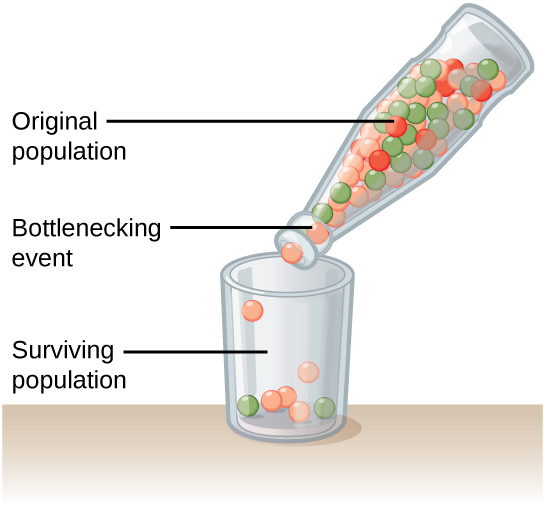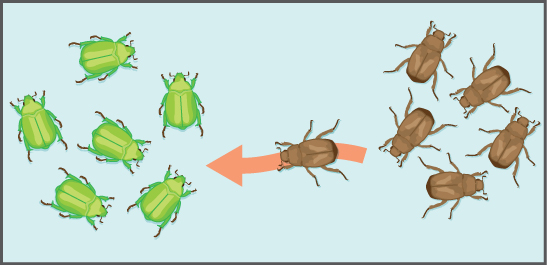Non-Adaptive Evolution
Section Goals
By the end of this section, you will be able to do the following:
- Describe genetic drift and two special cases of genetic drift– bottlenecks and founder effects
- Describe gene flow
- Explain how genetic drift and gene flow can influence a population’s allele frequencies
Changes in allele frequencies that we identify in a population can shed light on how it is evolving. Recall that not all evolution is adaptive. In addition to natural selection, other non-adaptive evolutionary forces, such as genetic drift or gene flow, could be in play.
Genetic Drift
The theory of natural selection stems from the observation that some individuals in a population are more likely to survive longer and have more offspring than others; thus, they will pass on more of their genes to the next generation. A big, powerful male gorilla, for example, is much more likely than a smaller, weaker one to become the population’s silverback, the pack’s leader who mates far more than the other males of the group. The pack leader will father more offspring, who share half of his genes, and are likely to also grow bigger and stronger like their father. Over time, the genes for bigger size will increase in frequency in the population, and the population will, as a result, grow larger on average. That is, this would occur if this particular selection pressure, or driving selective force, were the only one acting on the population. In other examples, better camouflage or a stronger resistance to drought might pose a selection pressure.
Another way a population’s allele and genotype frequencies can change is genetic drift (Figure 1). Genetic drift is one of the basic mechanisms of evolution. By chance, some individuals will have more offspring than others (and leave behind more genes, of course!) —not due to an advantage conferred by some genetically-encoded trait, but just because one male happened to be in the right place at the right time (when the receptive female walked by) or because the other one happened to be in the wrong place at the wrong time (when a fox was hunting).
Genetic drift happens to ALL populations. It affects the genetic makeup of the population, but unlike natural selection, through an entirely random process. So, although genetic drift is a mechanism of evolution, it doesn’t work to produce adaptations.

Do you think genetic drift would happen more quickly on an island or on the mainland?
Answer:
Genetic drift is likely to occur more rapidly on an island where smaller populations are expected to occur.
Small populations are more susceptible to the forces of genetic drift. Large populations, alternatively, are buffered against the effects of chance. If one individual of a population of 10 individuals happens to die at a young age before it leaves any offspring to the next generation, all of its genes—1/10 of the population’s gene pool—will be suddenly lost. In a population of 100, that’s only 1 percent of the overall gene pool; therefore, it is much less impactful on the population’s genetic structure.
Watch this animation of random sampling and genetic drift in action:

Bottleneck Effect
Genetic drift can also be magnified by natural events, such as a natural disaster that kills—at random—a large portion of the population. Known as the bottleneck effect, it results in a large portion of the gene pool suddenly being wiped out (Figure 2). In one fell swoop, the genetic structure of the survivors becomes the genetic structure of the entire population, which may be very different from the pre-disaster population.

Founder Effect
Another scenario in which populations might experience a strong influence of genetic drift is if some portion of the population leaves to start a new population in a new location or if a physical barrier divides a population. In this situation, those individuals are an unlikely representation of the entire population, which results in the founder effect. The founder effect occurs when the genetic structure changes to match that of the new population’s founding fathers and mothers. Researchers believe that the founder effect was a key factor in the genetic history of the Afrikaner population of Dutch settlers in South Africa, as evidenced by mutations that are common in Afrikaners but rare in most other populations. This effect is probably due to the fact that a higher-than-normal proportion of the founding colonists carried these mutations. As a result, the population expresses unusually high incidences of Huntington’s disease (HD) and Fanconi anemia (FA), a genetic disorder known to cause blood marrow and congenital abnormalities—even cancer.
Watch this short video to learn more about the founder and bottleneck effects. Note that the video has no audio.
You can view the descriptive transcript for “Founder and Bottleneck Effect (Evolution)” here.
Gene Flow
Another important evolutionary force is gene flow: the flow of alleles in and out of a population due to the migration of individuals or gametes (Figure 3).

While some populations are fairly stable, others experience more flux. Many plants, for example, send their pollen far and wide, by wind or by bird, to pollinate other populations of the same species some distance away. Even a population that may initially appear to be stable, such as a pride of lions, can experience its fair share of immigration and emigration as developing males leave their mothers to seek out a new pride with genetically unrelated females. This variable flow of individuals in and out of the group not only changes the population’s gene structure but can also introduce new genetic variation to populations in different geological locations and habitats.
Did I Get It?
Simulation Exercise
CC Licensed Content, Shared Previously, Included in Mechanisms of Evolution
- Biology 2e. Authors: Mary Ann Clark, Matthew Douglas and Jung Choi. Provided by: OpenStax CNX. Located at: Biology 2e. License: CC BY: Attribution 4.0.
- An Interactive Introduction to Organismal and Molecular Biology, 2nd ed. Author: Andrea Bierema. Provided by: Pressbooks. Located at: An Interactive Introduction to Organismal and Molecular Biology, 2nd ed. – Simple Book Publishing. License: CC BY-NC-SA 4.0
- Genetic Drift. UC Museum of Paleontology Understanding Evolution. Located at: https://evolution.berkeley.edu/evolution-101/mechanisms-the-processes-of-evolution/genetic-drift/. License: CC BY-NC-SA 4.0

